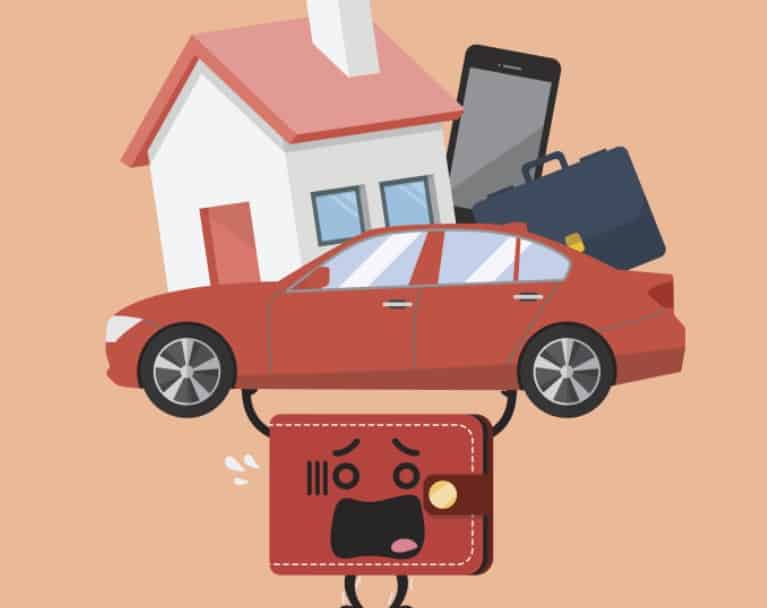
Amon and Christina Browning retired at age 39 and 41, respectively. But it didn’t just happen overnight.
For eight years, the couple found creative ways to reduce their cost of living while saving as much as 70% of their paychecks. It required a lot of forethought, but once they automated their money they found that saving was not quite as stressful as they imagined. In less than a decade, the Brownings were able to save and invest more than $2 million.
Their success would not have been possible without automating their savings. Autopay is one of the easiest ways to pay your credit card bills on time and protect your credit score, but it’s just as important to automate savings by scheduling automatic deposits whenever possible.
But automating your savings is just the first half of the equation: The Brownings put their money in a high-yield savings account (along with investments, CDs and a money market account) to earn returns on what they put aside. They talk about their lifestyle and provide tips on frugal expat living on their YouTube channel, Our Rich Journey.
CNBC Select spoke with them to get their best tips on how to automate your savings every month and how to pick the right savings account for your needs.
How to automate your savings
- Think long-term
- Get the best return on your money
- Stay a step ahead of yourself
- Pay yourself first
- Start small and increase incrementally
1. Think long-term
Whether you’re building up an emergency fund or putting money aside for a major purchase, think of saving as a marathon, not a sprint.
“When you’re picking a bank, you want to make sure you can see yourself having a long-term relationship with it,” the couple tells CNBC Select. Once you link all of your bank and investment accounts, you’re not going to want to interrupt things in a few years.
When choosing which high-yield savings account to use, the most obvious feature you’ll notice is APY, or annual interest yield. This is how much you will earn on your money over a year.
However, there are a host of other features to keep in mind when comparing accounts. Interest rates are always fluctuating and sometimes an attractive APY offer can cause you to overlook other important details.
Consider these factors before you open a new savings account:
- How often the bank compounds, or pays interest
- Whether there are minimum balance requirements
- If there are withdrawal limits (how many times per month you can take out cash)
- Whether you prefer an online bank or a brick-and-mortar location
- How easy the account and mobile app are to use
- What kind of customer service the bank offers
- Whether the bank is FDIC insured
Bottom line: Always do your research. Read reviews and speak to people you trust about their experiences with a particular bank. Find the bank that fits your needs.
2. Get the best return on your money
In addition to their investments, the Brownings keep two-and-a-half years’ worth of living expenses in a few different savings accounts.
They avoided keeping their money in a basic account since the national average APY on savings accounts is just 0.06% according to the Federal Deposit Insurance Corporation (FDIC) That’s not enough to keep up with the 2% inflation rate.
Instead, the Brownings split their emergency fund between multiple savings accounts that earn at different rates. They keep a good chunk of it in an Ally Online Savings Account and another portion in a money market account that is currently outperforming their high-yield savings. (The national average APY for for money market accounts is 0.09%, but many online banks offer higher rates.) The last portion of the Brownings’ savings is in CD ladders, which earn higher rates the more you deposit and deliver yields over a staggered timeline.
Once you have an understanding of what you’re looking for, consider transferring your savings to a high-yield account.
CNBC Select rated our top five choices, considering the above qualifications, as well as accounts’ ease of use and accessibility. Here are our top picks:
- Best overall: Marcus by Goldman Sachs High Yield Online Savings
- Best for checking/savings combo: Ally Online Savings Account
- Best for easy access to your cash: Synchrony Bank High Yield Savings
- Best for earning a high APY: Vio Bank High Yield Online Savings Account
- Best if you want extra help saving: Varo Savings Account
Bottom line: Pay attention to interest rates and opt for ways to earn more on APY.
3. Stay a step ahead of yourself
Automating your savings is about making the process easy and streamlined.
If your employer gives you the option, deposit a portion of your paycheck into your savings and/or investment accounts automatically. Likewise, you can set up recurring automatic transfers from your checking account to a high-yield savings like a Vio Bank High Yield Online Savings Account or a Varo Savings Account.
But while saving should be a no-brainer, withdrawing your money doesn’t have to be. In fact, the Brownings argue that you should try to “complicate” this process as much as possible so that you’re less likely to take out cash on a whim.
It’s not a bad idea to keep a small reserve of cash — maybe one to two months’ worth of expenses — stashed into an accessible account that allows you to withdraw funds quickly. However, if you are fortunate enough to have six months’ worth or more of savings, you should intentionally create barriers that require you to think before you withdraw.
“You’re probably better off having your high-yield savings account at a different bank than your checking account,” Amon says. “That way you won’t see the two balances when you log in to your bank.”
Bottom line: Link your accounts electronically for automatic deposits, but consider having your checking and savings accounts at two different banks. It might seem a little more complicated, but setting it up this way requires you to think each time you take out cash.
4. Pay yourself first
“Saving and investing is an investment in yourself,” argues the couple, who says that looking at saving this way was “the key to success.”
“When we were devising our budget and our expenses, one of the first line items we identified was what we were going to save and invest. So that was at the top and everything else fell into line after that,” they explain.
They decided on the rest of their expenses — from the type of car they drove to the kind of house they owned — once they made sure they could afford their non-negotiable savings goal.
“People’s budgets are discretionary,” explains Christina. “Once people take more of that discretion out of their spending by taking that money off of the top, they’ll see that they are automatically generating more savings that way.”
That’s in comparison to allocating your money on expenses first and waiting to save what’s leftover at the end.
And because money is inherently emotional, the couple believes that saving money off of the top is the best way to reduce stress and anxiety.
“You want to be able to live it up with your money” the couple says. By automatically meeting their savings goal every month, they feel free to use their remaining money however they like and skip the negative emotions that are far too common with spending.
Bottom line: Treat yourself like you’re the most important bill and budget for savings first. You’re more likely to enjoy your money when you know you’ve already put some aside for future needs.
5. Start small and increase incrementally
The Brownings were admittedly a little overwhelmed when they realized they wanted to save over $2 million dollars in less than a decade. And when they first began, they were no where near ready to start saving 70% of what they earned.
“We didn’t have a lot of income,” they admit.
However, they were ready to begin. Their advice to someone who’s not sure they can afford to save is this: Start where you are, and try to get 1% better every month.
In other words, if your goal is to save $500 per month, but you can only afford to save $250 per month, start there and try to bump your savings goal by 1% each month. It will be less noticeable in small increments, but you’ll be making progress toward hitting your bigger goal.
Likewise, if you are putting money into an employer-sponsored retirement fund, see if you can opt for automatic increases every year, either on your work anniversary or at the start of each new calendar. You could automatically bump your contributions up by 1% to 3% each year or by the percent of your annual raise so that you don’t notice a change in your income.
Bottom line: It’s never too early to begin. Know that putting aside a small amount each month, you’re building the muscle of saving. And some savings accounts, such as the Marcus by Goldman Sachs High Yield Online Savings, have no minimum balance requirement, meaning you can open an account with just a small amount.
























